PEUGEOT 2008 2016 Owners Manual
Manufacturer: PEUGEOT, Model Year: 2016, Model line: 2008, Model: PEUGEOT 2008 2016Pages: 450, PDF Size: 14.16 MB
Page 141 of 450
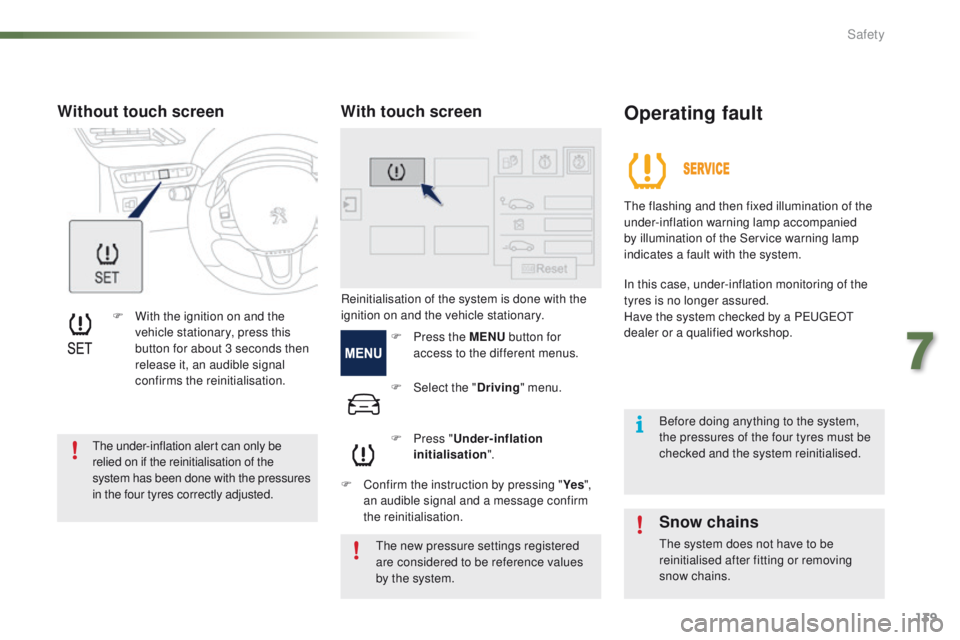
139
2008_en_Chap07_securite_ed01-2016
F With the ignition on and the vehicle stationary, press this
button for about 3 seconds then
release it, an audible signal
confirms the reinitialisation.
Snow chains
The system does not have to be
reinitialised after fitting or removing
snow chains.
The flashing and then fixed illumination of the
under-inflation warning lamp accompanied
by illumination of the Service warning lamp
indicates a fault with the system.
Before doing anything to the system,
the pressures of the four tyres must be
checked and the system reinitialised.
Operating fault
In this case, under-inflation monitoring of the
tyres is no longer assured.
Have the system checked by a PEUGEOT
dealer or a qualified workshop.
Reinitialisation of the system is done with the
ignition on and the vehicle stationary.
F
P
ress the MENU button for
access to the different menus.
F
Sel
ect the " Driving" menu.
F
P
ress " Under-inflation
initialisation ".
The new pressure settings registered
are considered to be reference values
by the system.
With touch screen
F Confirm the instruction by pressing " Ye s",
an audible signal and a message confirm
the reinitialisation.
Without touch screen
The under-inflation alert can only be
relied on if the reinitialisation of the
system has been done with the pressures
in the four tyres correctly adjusted.
7
Safety
Page 142 of 450
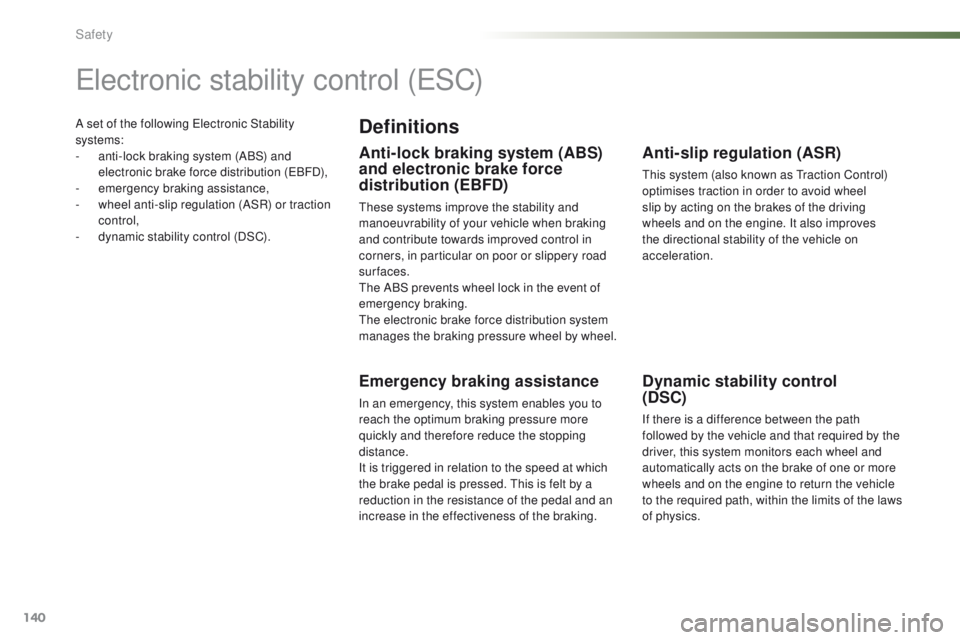
140
2008_en_Chap07_securite_ed01-2016
A set of the following Electronic Stability
systems:
-
a
nti-lock braking system (ABS) and
electronic brake force distribution (EBFD),
-
em
ergency braking assistance,
-
w
heel anti-slip regulation (ASR) or traction
control,
-
d
ynamic stability control (DSC).
Electronic stability control (ESC)
Definitions
Anti-lock braking system (ABS)
and electronic brake force
distribution (EBFD)
These systems improve the stability and
manoeuvrability of your vehicle when braking
and contribute towards improved control in
corners, in particular on poor or slippery road
surfaces.
The ABS prevents wheel lock in the event of
emergency braking.
The electronic brake force distribution system
manages the braking pressure wheel by wheel.
Emergency braking assistance
In an emergency, this system enables you to
reach the optimum braking pressure more
quickly and therefore reduce the stopping
distance.
It is triggered in relation to the speed at which
the brake pedal is pressed. This is felt by a
reduction in the resistance of the pedal and an
increase in the effectiveness of the braking.
Anti-slip regulation (ASR)
This system (also known as Traction Control)
optimises traction in order to avoid wheel
slip by acting on the brakes of the driving
wheels and on the engine. It also improves
the directional stability of the vehicle on
acceleration.
Dynamic stability control
(DSC)
If there is a difference between the path
followed by the vehicle and that required by the
driver, this system monitors each wheel and
automatically acts on the brake of one or more
wheels and on the engine to return the vehicle
to the required path, within the limits of the laws
of physics.
Safety
Page 143 of 450
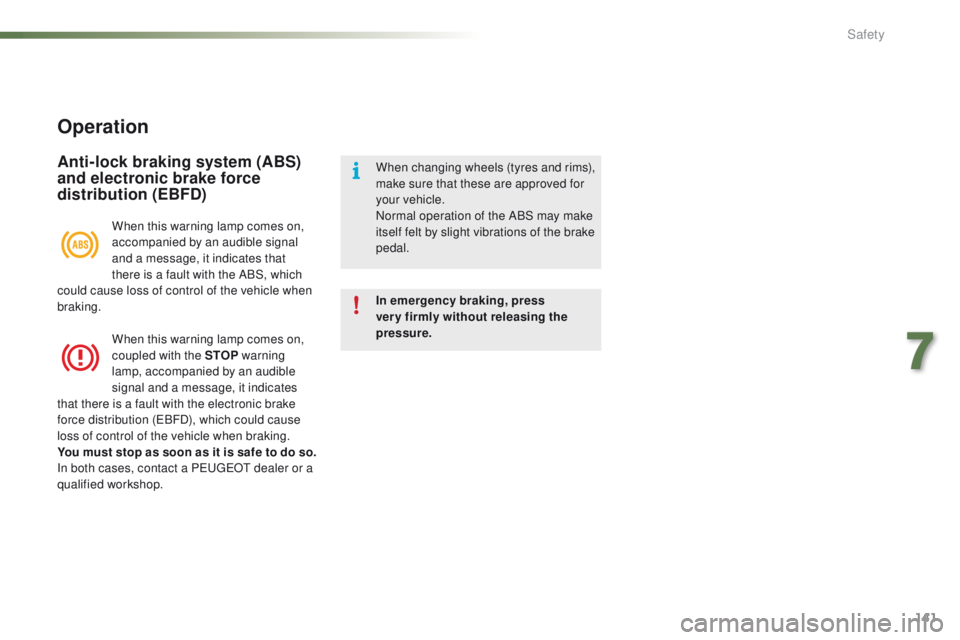
141
2008_en_Chap07_securite_ed01-2016
Operation
Anti-lock braking system (ABS)
and electronic brake force
distribution (EBFD)
In emergency braking, press
very firmly without releasing the
pressure. When changing wheels (tyres and rims),
make sure that these are approved for
your vehicle.
Normal operation of the ABS may make
itself felt by slight vibrations of the brake
pedal.
When this warning lamp comes on,
accompanied by an audible signal
and a message, it indicates that
there is a fault with the ABS, which
could cause loss of control of the vehicle when
braking.
When this warning lamp comes on,
coupled with the STOP warning
lamp, accompanied by an audible
signal and a message, it indicates
that there is a fault with the electronic brake
force distribution (EBFD), which could cause
loss of control of the vehicle when braking.
You must stop as soon as it is safe to do so.
In both cases, contact a PEUGEOT dealer or a
qualified workshop.
7
Safety
Page 144 of 450
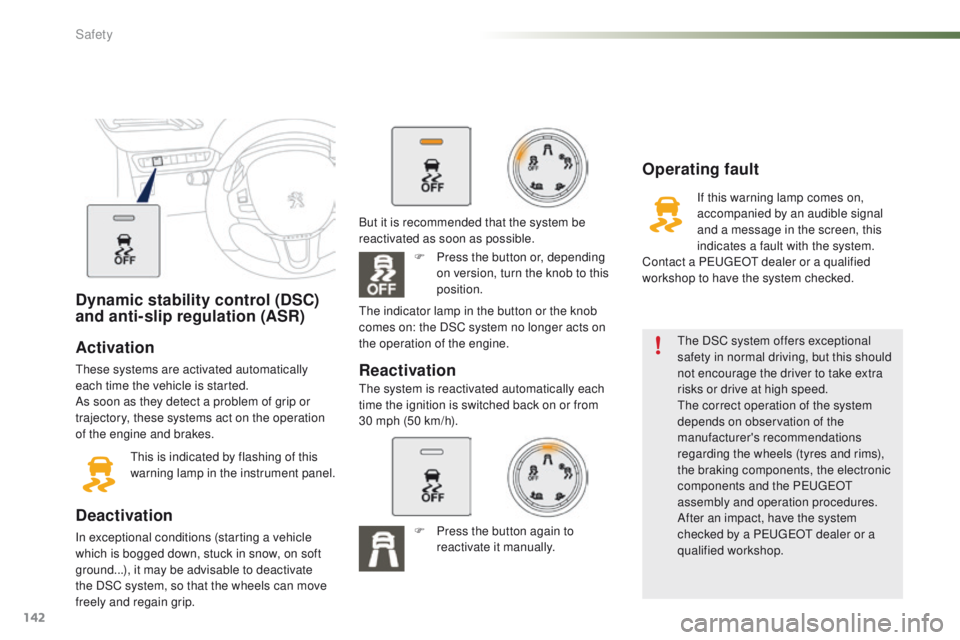
142
2008_en_Chap07_securite_ed01-2016
Dynamic stability control (DSC)
and anti-slip regulation (ASR)
Activation
These systems are activated automatically
each time the vehicle is started.
As soon as they detect a problem of grip or
trajectory, these systems act on the operation
of the engine and brakes.This is indicated by flashing of this
warning lamp in the instrument panel.
Deactivation
In exceptional conditions (starting a vehicle
which is bogged down, stuck in snow, on soft
ground...), it may be advisable to deactivate
the DSC system, so that the wheels can move
freely and regain grip. The DSC system offers exceptional
safety in normal driving, but this should
not encourage the driver to take extra
risks or drive at high speed.
The correct operation of the system
depends on observation of the
manufacturer's recommendations
regarding the wheels (tyres and rims),
the braking components, the electronic
components and the PEUGEOT
assembly and operation procedures.
After an impact, have the system
checked by a PEUGEOT dealer or a
qualified workshop.
Operating fault
If this warning lamp comes on,
accompanied by an audible signal
and a message in the screen, this
indicates a fault with the system.
Contact a PEUGEOT dealer or a qualified
workshop to have the system checked.
Reactivation
But it is recommended that the system be
reactivated as soon as possible.
F
P
ress the button or, depending
on version, turn the knob to this
position.
The system is reactivated automatically each
time the ignition is switched back on or from
30 mph (50 km/h). The indicator lamp in the button or the knob
comes on: the DSC system no longer acts on
the operation of the engine.
F
P
ress the button again to
reactivate it manually.
Safety
Page 145 of 450
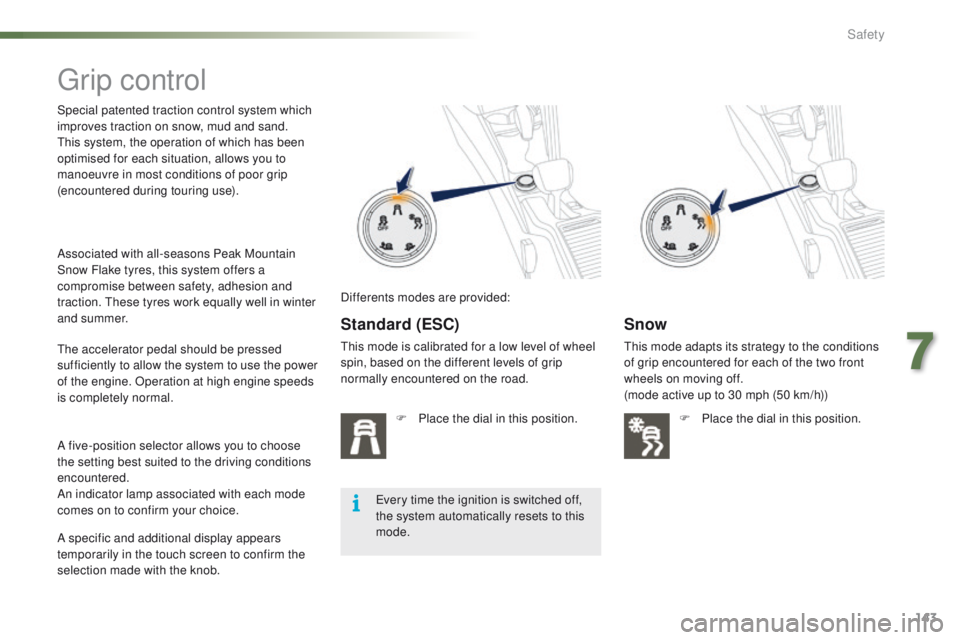
143
2008_en_Chap07_securite_ed01-2016
Grip control
Special patented traction control system which
improves traction on snow, mud and sand.
This system, the operation of which has been
optimised for each situation, allows you to
manoeuvre in most conditions of poor grip
(encountered during touring use).
Standard (ESC)
This mode is calibrated for a low level of wheel
spin, based on the different levels of grip
normally encountered on the road.F
P
lace the dial in this position.
Snow
This mode adapts its strategy to the conditions
of grip encountered for each of the two front
wheels on moving off.
(mode active up to 30 mph (50 km/h))F
P
lace the dial in this position.
The accelerator pedal should be pressed
sufficiently to allow the system to use the power
of the engine. Operation at high engine speeds
is completely normal.
A five-position selector allows you to choose
the setting best suited to the driving conditions
encountered.
An indicator lamp associated with each mode
comes on to confirm your choice.
Every time the ignition is switched off,
the system automatically resets to this
mode.
Associated with all-seasons Peak Mountain
Snow Flake tyres, this system offers a
compromise between safety, adhesion and
traction. These tyres work equally well in winter
and summer.
A specific and additional display appears
temporarily in the touch screen to confirm the
selection made with the knob.
Differents modes are provided:
7
Safety
Page 146 of 450
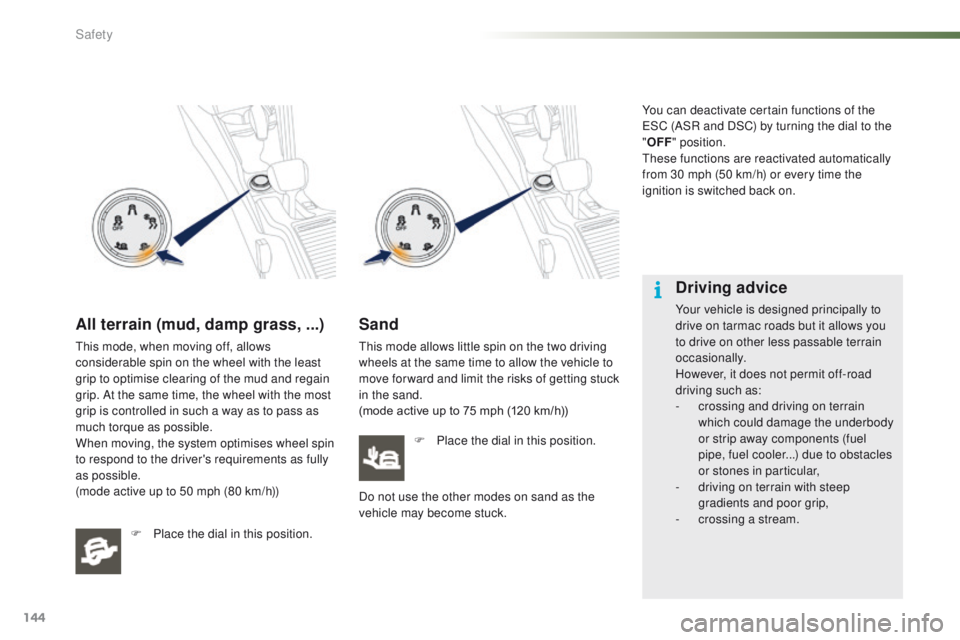
144
2008_en_Chap07_securite_ed01-2016
All terrain (mud, damp grass, ...)
This mode, when moving off, allows
considerable spin on the wheel with the least
grip to optimise clearing of the mud and regain
grip. At the same time, the wheel with the most
grip is controlled in such a way as to pass as
much torque as possible.
When moving, the system optimises wheel spin
to respond to the driver's requirements as fully
as possible.
(mode active up to 50 mph (80 km/h))F
P
lace the dial in this position.
Sand
This mode allows little spin on the two driving
wheels at the same time to allow the vehicle to
move for ward and limit the risks of getting stuck
in the sand.
(mode active up to 75 mph (120 km/h))F
P
lace the dial in this position.
Do not use the other modes on sand as the
vehicle may become stuck. You can deactivate certain functions of the
ESC (ASR and DSC) by turning the dial to the
"
OFF " position.
These functions are reactivated automatically
from 30 mph (50 km/h) or every time the
ignition is switched back on.
Driving advice
Your vehicle is designed principally to
drive on tarmac roads but it allows you
to drive on other less passable terrain
occasionally.
However, it does not permit off-road
driving such as:
-
c
rossing and driving on terrain
which could damage the underbody
or strip away components (fuel
pipe, fuel cooler...) due to obstacles
or stones in particular,
-
d
riving on terrain with steep
gradients and poor grip,
-
c
rossing a stream.
Safety
Page 147 of 450
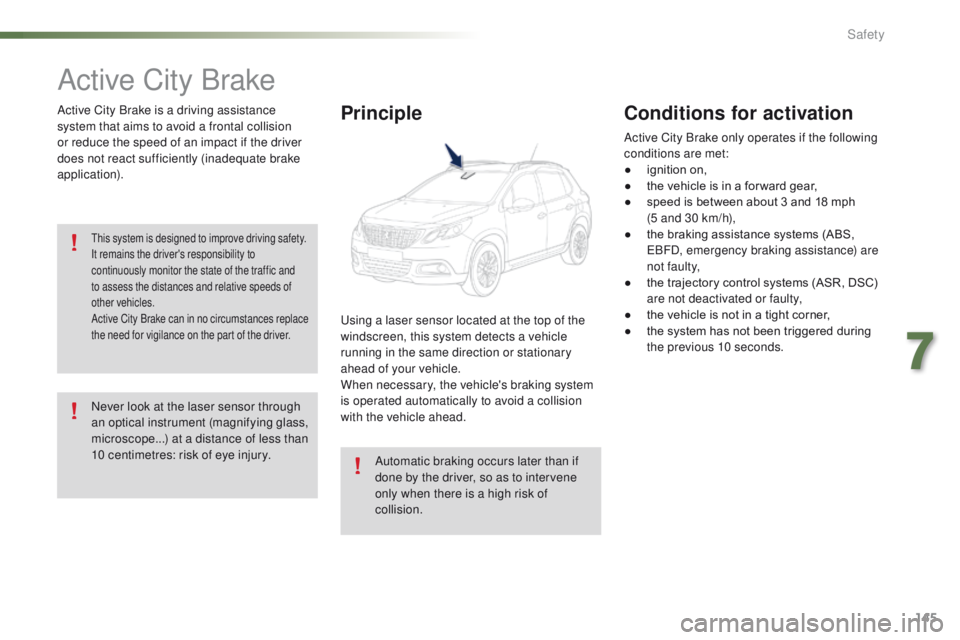
145
2008_en_Chap07_securite_ed01-2016
Active City Brake
Active City Brake is a driving assistance
system that aims to avoid a frontal collision
or reduce the speed of an impact if the driver
does not react sufficiently (inadequate brake
application).
This system is designed to improve driving safety.
It remains the driver's responsibility to
continuously monitor the state of the traffic and
to assess the distances and relative speeds of
other vehicles.
Active City Brake can in no circumstances replace
the need for vigilance on the part of the driver.
Never look at the laser sensor through
an optical instrument (magnifying glass,
microscope...) at a distance of less than
10 centimetres: risk of eye injury.Automatic braking occurs later than if
done by the driver, so as to intervene
only when there is a high risk of
collision.
Principle
Using a laser sensor located at the top of the
windscreen, this system detects a vehicle
running in the same direction or stationary
ahead of your vehicle.
When necessary, the vehicle's braking system
is operated automatically to avoid a collision
with the vehicle ahead.
Conditions for activation
Active City Brake only operates if the following
conditions are met:
●
i
gnition on,
●
t
he vehicle is in a for ward gear,
●
s
peed is between about 3 and 18 mph
(5 and 30 km/h),
●
t
he braking assistance systems (ABS,
EBFD, emergency braking assistance) are
not faulty,
●
t
he trajectory control systems (ASR, DSC)
are not deactivated or faulty,
●
t
he vehicle is not in a tight corner,
●
t
he system has not been triggered during
the previous 10 seconds.
7
Safety
Page 148 of 450
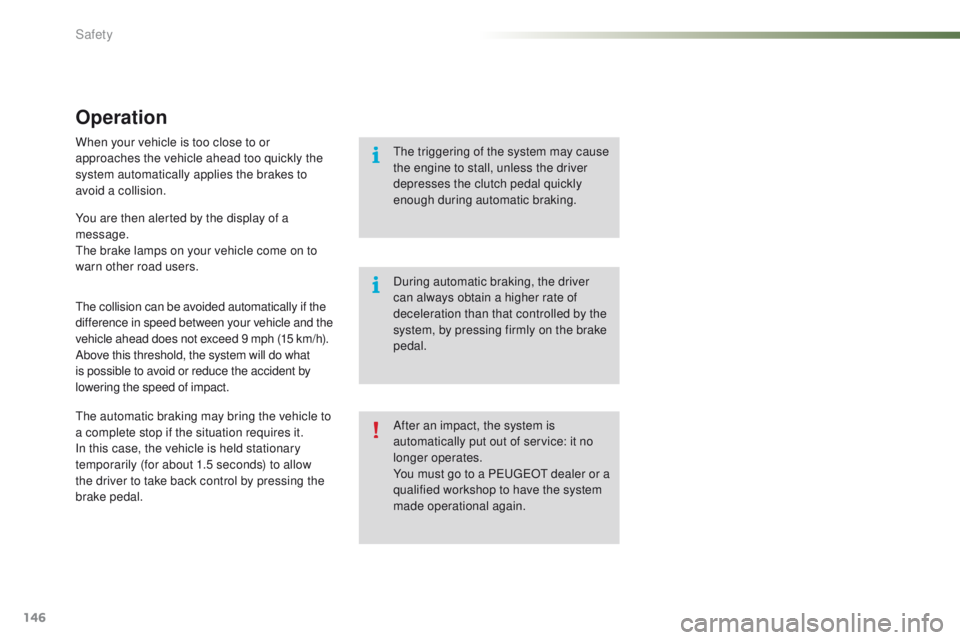
146
2008_en_Chap07_securite_ed01-2016
Operation
When your vehicle is too close to or
approaches the vehicle ahead too quickly the
system automatically applies the brakes to
avoid a collision.
The collision can be avoided automatically if the
difference in speed between your vehicle and the
vehicle ahead does not exceed 9 mph (15 km/h).
Above this threshold, the system will do what
is possible to avoid or reduce the accident by
lowering the speed of impact.
The automatic braking may bring the vehicle to
a complete stop if the situation requires it.
In this case, the vehicle is held stationary
temporarily (for about 1.5 seconds) to allow
the driver to take back control by pressing the
brake pedal. You are then alerted by the display of a
message.
The brake lamps on your vehicle come on to
warn other road users.After an impact, the system is
automatically put out of service: it no
longer operates.
You must go to a PEUGEOT dealer or a
qualified workshop to have the system
made operational again. During automatic braking, the driver
can always obtain a higher rate of
deceleration than that controlled by the
system, by pressing firmly on the brake
pedal. The triggering of the system may cause
the engine to stall, unless the driver
depresses the clutch pedal quickly
enough during automatic braking.
Safety
Page 149 of 450
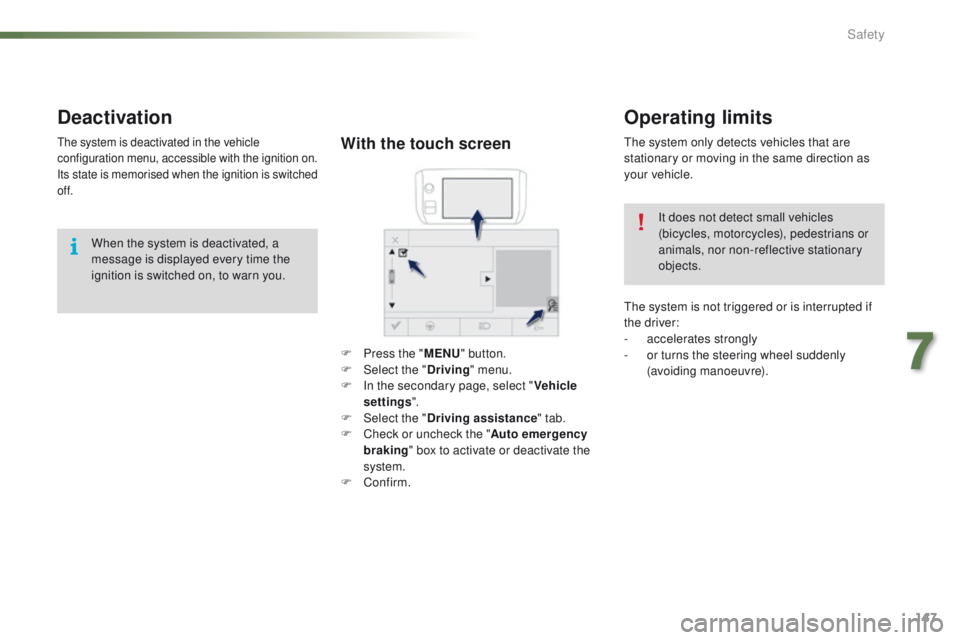
147
2008_en_Chap07_securite_ed01-2016
Operating limits
The system only detects vehicles that are
stationary or moving in the same direction as
your vehicle.It does not detect small vehicles
(bicycles, motorcycles), pedestrians or
animals, nor non-reflective stationary
objects.
The system is not triggered or is interrupted if
the driver:
-
a
ccelerates strongly
-
o
r turns the steering wheel suddenly
(avoiding manoeuvre).With the touch screen
F Press the " MENU" button.
F Sel ect the " Driving" menu.
F
I
n the secondary page, select " Vehicle
settings ".
F
Sel
ect the " Driving assistance " tab.
F
C
heck or uncheck the " Auto emergency
braking " box to activate or deactivate the
system.
F
Confirm.
Deactivation
The system is deactivated in the vehicle
configuration menu, accessible with the ignition on.
Its state is memorised when the ignition is switched
of f.
When the system is deactivated, a
message is displayed every time the
ignition is switched on, to warn you.
7
Safety
Page 150 of 450
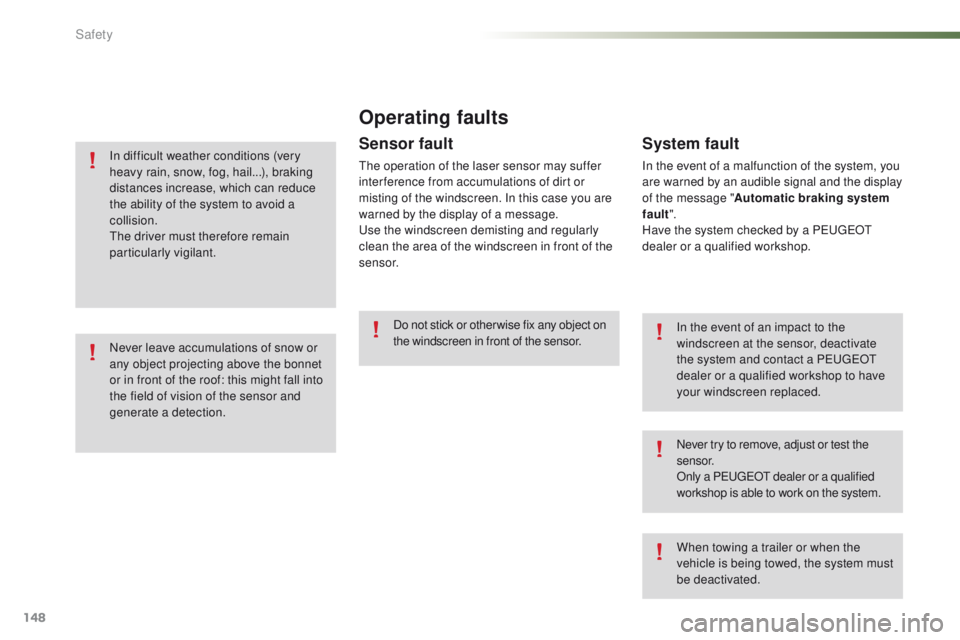
148
2008_en_Chap07_securite_ed01-2016
Operating faults
In the event of an impact to the
windscreen at the sensor, deactivate
the system and contact a PEUGEOT
dealer or a qualified workshop to have
your windscreen replaced.
Never try to remove, adjust or test the
sensor.
Only a PEUGEOT dealer or a qualified
workshop is able to work on the system.
When towing a trailer or when the
vehicle is being towed, the system must
be deactivated.
Do not stick or other wise fix any object on
the windscreen in front of the sensor.
Sensor fault
The operation of the laser sensor may suffer
inter ference from accumulations of dirt or
misting of the windscreen. In this case you are
warned by the display of a message.
Use the windscreen demisting and regularly
clean the area of the windscreen in front of the
sensor.
System fault
In the event of a malfunction of the system, you
are warned by an audible signal and the display
of the message "
Automatic braking system
fault ".
Have the system checked by a PEUGEOT
dealer or a qualified workshop.
In difficult weather conditions (very
heavy rain, snow, fog, hail...), braking
distances increase, which can reduce
the ability of the system to avoid a
collision.
The driver must therefore remain
particularly vigilant.
Never leave accumulations of snow or
any object projecting above the bonnet
or in front of the roof: this might fall into
the field of vision of the sensor and
generate a detection.
Safety